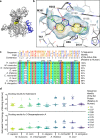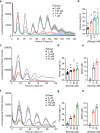Methylation deficiency disrupts biological rhythms from bacteria to humans
- PMID: 32376902
- PMCID: PMC7203018
- DOI: 10.1038/s42003-020-0942-0
Methylation deficiency disrupts biological rhythms from bacteria to humans
Erratum in
-
Publisher Correction: Methylation deficiency disrupts biological rhythms from bacteria to humans.Commun Biol. 2020 Jun 4;3(1):295. doi: 10.1038/s42003-020-1031-0. Commun Biol. 2020. PMID: 32499511 Free PMC article.
Abstract
The methyl cycle is a universal metabolic pathway providing methyl groups for the methylation of nuclei acids and proteins, regulating all aspects of cellular physiology. We have previously shown that methyl cycle inhibition in mammals strongly affects circadian rhythms. Since the methyl cycle and circadian clocks have evolved early during evolution and operate in organisms across the tree of life, we sought to determine whether the link between the two is also conserved. Here, we show that methyl cycle inhibition affects biological rhythms in species ranging from unicellular algae to humans, separated by more than 1 billion years of evolution. In contrast, the cyanobacterial clock is resistant to methyl cycle inhibition, although we demonstrate that methylations themselves regulate circadian rhythms in this organism. Mammalian cells with a rewired bacteria-like methyl cycle are protected, like cyanobacteria, from methyl cycle inhibition, providing interesting new possibilities for the treatment of methylation deficiencies.
Conflict of interest statement
The authors declare no competing interests.
Figures





Similar articles
-
New insights into the circadian clock in Chlamydomonas.Int Rev Cell Mol Biol. 2010;280:281-314. doi: 10.1016/S1937-6448(10)80006-1. Epub 2010 Mar 18. Int Rev Cell Mol Biol. 2010. PMID: 20797685 Review.
-
Methyl Metabolism and the Clock: An Ancient Story With New Perspectives.J Biol Rhythms. 2022 Jun;37(3):235-248. doi: 10.1177/07487304221083507. Epub 2022 Apr 5. J Biol Rhythms. 2022. PMID: 35382619 Free PMC article.
-
A methyl transferase links the circadian clock to the regulation of alternative splicing.Nature. 2010 Nov 4;468(7320):112-6. doi: 10.1038/nature09470. Epub 2010 Oct 20. Nature. 2010. PMID: 20962777
-
Chlamydomonas reinhardtii as a unicellular model for circadian rhythm analysis.Chronobiol Int. 2002 Mar;19(2):325-43. doi: 10.1081/cbi-120002981. Chronobiol Int. 2002. PMID: 12025928 Review.
-
Circadian Rhythms and Sleep in Drosophila melanogaster.Genetics. 2017 Apr;205(4):1373-1397. doi: 10.1534/genetics.115.185157. Genetics. 2017. PMID: 28360128 Free PMC article. Review.
Cited by
-
m6A RNA Methylation in Marine Plants: First Insights and Relevance for Biological Rhythms.Int J Mol Sci. 2020 Oct 12;21(20):7508. doi: 10.3390/ijms21207508. Int J Mol Sci. 2020. PMID: 33053767 Free PMC article.
-
Deep-coverage spatiotemporal proteome of the picoeukaryote Ostreococcus tauri reveals differential effects of environmental and endogenous 24-hour rhythms.Commun Biol. 2021 Sep 30;4(1):1147. doi: 10.1038/s42003-021-02680-3. Commun Biol. 2021. PMID: 34593975 Free PMC article.
-
Resolving Geroplasticity to the Balance of Rejuvenins and Geriatrins.Aging Dis. 2022 Dec 1;13(6):1664-1714. doi: 10.14336/AD.2022.0414. eCollection 2022 Dec 1. Aging Dis. 2022. PMID: 36465174 Free PMC article.
-
Circadian regulation of metabolism across photosynthetic organisms.Plant J. 2023 Nov;116(3):650-668. doi: 10.1111/tpj.16405. Epub 2023 Aug 2. Plant J. 2023. PMID: 37531328 Free PMC article. Review.
-
IRBITs, signaling molecules of great functional diversity.Pflugers Arch. 2025 Aug;477(8):1007-1036. doi: 10.1007/s00424-025-03095-3. Epub 2025 May 30. Pflugers Arch. 2025. PMID: 40445299 Review.
References
-
- Cantoni GL. The role of S-adenosylhomocysteine in the biological utilization of S-adenosylmethionine. Prog. Clin. Biol. Res. 1985;198:47–65. - PubMed
-
- Chiang PK, Cantoni GL. Perturbation of biochemical transmethylations by 3-deazaadenosine in vivo. Biochem. Pharmacol. 1979;28:1897–1902. - PubMed
-
- Hoffman DR, Marion DW, Cornatzer WE, Duerre JA. S-Adenosylmethionine and S-adenosylhomocystein metabolism in isolated rat liver. Effects of L-methionine, L-homocystein, and adenosine. J. Biol. Chem. 1980;255:10822–10827. - PubMed
-
- Poirier, L. A., Herrera, L. A. C. & Wise, C. On the Chemical Causation of Methyl Deficiency and its Attendant Pathologies (2003).
-
- Takahashi, J. S. In A Time for Metabolism and Hormones (Sassone-Corsi, P. & Christen, Y. eds.) 13–24 (The Author(s), Cham (CH), 2016). - PubMed
Publication types
MeSH terms
Supplementary concepts
Grants and funding
LinkOut - more resources
Full Text Sources
Molecular Biology Databases

